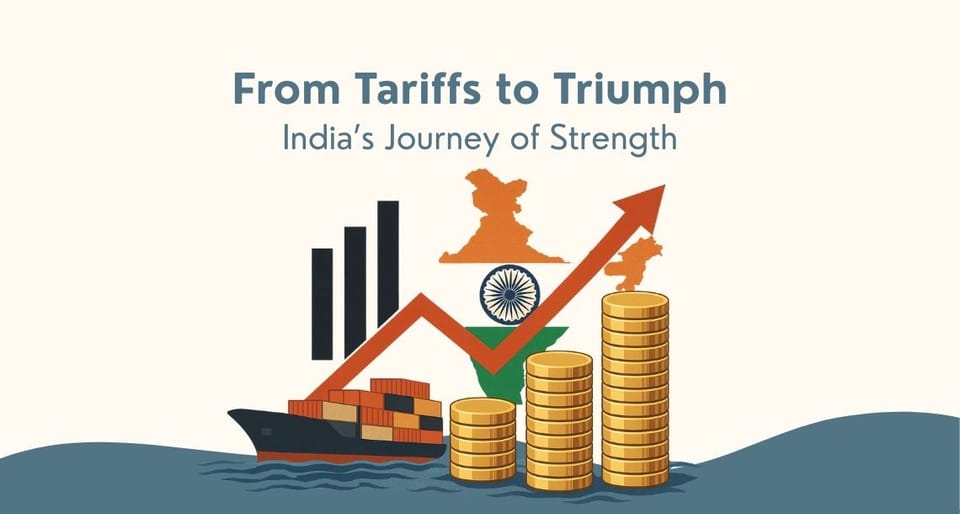India at the Crossroads: Turning Tariffs into Triumph

In the shadow of recent US tariffs imposed by former President Donald Trump, India faces a challenge that is as tough as it is defining. These tariffs — doubling taxes on nearly $38 billion of Indian goods entering the US — have put immense pressure on exporters ranging from seafood fishermen to textile weavers and jewelers. With some tariff rates exceeding 50%, American buyers now find Indian products more expensive, pushing them toward alternatives from Vietnam, Bangladesh, or China.
A Clear Example: Royal Enfield’s Rising Price Tag
Take the Royal Enfield Super Meteor 650 as an example. Before August 7, it retailed in the US at around $7,999. A new 25% tariff lifted the price to nearly $9,999. By August 27, when another 25% tariff takes effect, the same bike could cost $11,999 — pricing it out of competition against rival brands.
The Numbers Behind the Challenge
India exports about $86 billion worth of goods to the US each year. While $48 billion of critical goods like pharmaceuticals, electronics, and energy products remain exempt, that still leaves $38 billion exposed to higher tariffs. Experts warn that India could lose $30–35 billion in exports in the short term.
Yet here’s the perspective: India’s $4 trillion economy is so robust that the potential GDP impact is estimated at less than 0.2%. In other words, India’s story isn’t just about international trade — it’s about resilience, self-reliance, and the strength of our domestic market.
India’s Strategic Response
To counter these pressures, India is taking bold steps:
- Diversifying export markets beyond the US.
- Boosting “champion sectors” through incentives.
- Fast-tracking infrastructure projects to support industry.
- Supporting affected exporters with schemes and incentives.
- Accelerating Atmanirbhar Bharat, enabling Indian businesses — big or small — to innovate and remain competitive.
The Power of India’s Domestic Market
India’s consumption story is a beacon of hope. Millions of Indians today are buying Made in India, supporting local businesses, and keeping the economy moving. Every product we choose locally empowers farmers, small industries, and youth entrepreneurs. This isn’t just economics — it’s a movement of national pride.
Prime Minister Narendra Modi has emphasized that India is firmly on track to becoming one of the world’s leading economies. No external pressure can derail this momentum.
A Defining Moment for Atmanirbhar Bharat
Yes, there will be hardships. Some exporters may lose markets, some industries may face pressure. But India is not defined by its exports alone — India is defined by its people, spirit, and vision.
This is the moment for India to unite and embrace Atmanirbhar Bharat. A self-reliant India that grows stronger from challenges, builds its own future, and proudly declares its independence in global trade.
The Road Ahead: India Will Thrive
These tariffs may slow us, but they will not stop us. By supporting Indian products, promoting local industries, and choosing homegrown innovation, we can transform this challenge into a new chapter of progress.
India will not just survive this storm.
India will thrive.
Frequently Asked Questions (FAQ)
1. What are the new US tariffs on Indian goods?
Former US President Donald Trump has imposed tariffs that double taxes on around $38 billion of Indian exports. In some cases, tariffs exceed 50%, making Indian products significantly more expensive in the US market.
2. Which Indian industries are most affected by these tariffs?
The tariffs hit textiles, jewelry, seafood, motorcycles, and other consumer goods the hardest. Exporters in these industries face reduced competitiveness compared to countries like Vietnam, Bangladesh, and China.
3. Are all Indian exports to the US impacted?
No. Out of India’s annual $86 billion exports to the US, nearly $48 billion worth of goods — mainly pharmaceuticals, electronics, and energy products — are exempt from the tariffs.
4. How will these tariffs affect India’s economy?
While India may lose $30–35 billion in exports in the short term, the overall impact on India’s $4 trillion economy is expected to be minimal — less than 0.2% of GDP.
5. What is India doing to counter these tariffs?
India is pursuing multiple strategies, including:
- Diversifying export markets beyond the US.
- Boosting champion sectors through incentives.
- Fast-tracking infrastructure projects.
- Encouraging Atmanirbhar Bharat (self-reliant India) to strengthen domestic industries.
6. How can Indian consumers help during this situation?
By choosing Made in India products, Indians can empower local businesses, farmers, and entrepreneurs. Domestic consumption acts as a safety net for the economy when exports face external shocks.
7. What does this mean for India’s future growth?
Despite the challenges, India’s long-term growth story remains strong. With reforms, innovation, and a massive domestic market, India is well-positioned to become one of the world’s top economies in the coming years.
8. What role does Atmanirbhar Bharat play here?
Atmanirbhar Bharat emphasizes self-reliance — encouraging Indian industries to innovate, retool, and reduce dependency on foreign markets. This movement is now more relevant than ever in shaping India’s future.






Member discussion